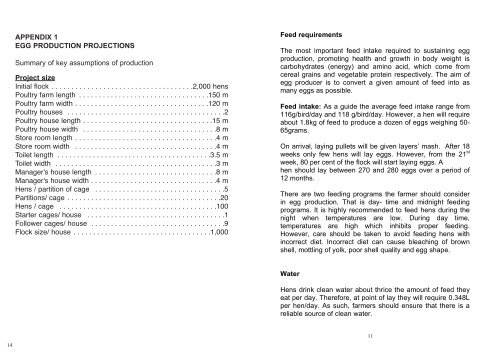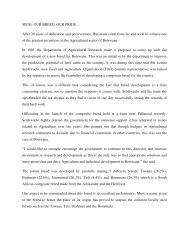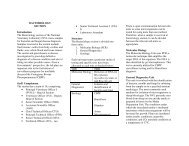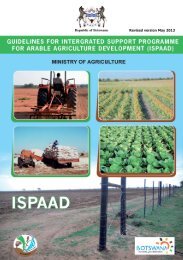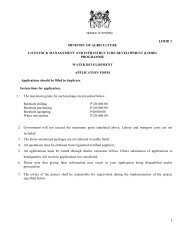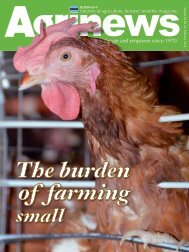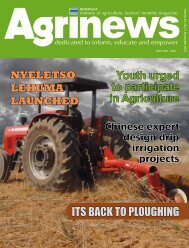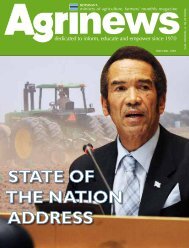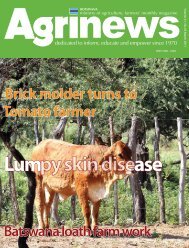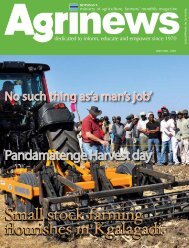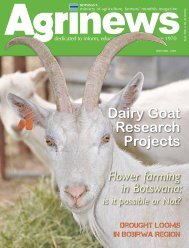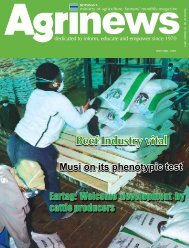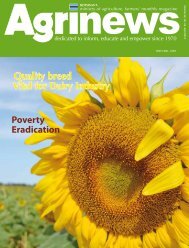TECHNICAL GUIDE FOR EGG PRODUCTION INTRODUCTION In ...
TECHNICAL GUIDE FOR EGG PRODUCTION INTRODUCTION In ...
TECHNICAL GUIDE FOR EGG PRODUCTION INTRODUCTION In ...
You also want an ePaper? Increase the reach of your titles
YUMPU automatically turns print PDFs into web optimized ePapers that Google loves.
APPENDIX 1<strong>EGG</strong> <strong>PRODUCTION</strong> PROJECTIONSSummary of key assumptions of productionProject size<strong>In</strong>itial flock . . . . . . . . . . . . . . . . . . . . . . . . . . . . . . . . . . . .2,000 hensPoultry farm length . . . . . . . . . . . . . . . . . . . . . . . . . . . . . . . . .150 mPoultry farm width . . . . . . . . . . . . . . . . . . . . . . . . . . . . . . . . . .120 mPoultry houses . . . . . . . . . . . . . . . . . . . . . . . . . . . . . . . . . . . . . . . .2Poultry house length . . . . . . . . . . . . . . . . . . . . . . . . . . . . . . . . .15 mPoultry house width . . . . . . . . . . . . . . . . . . . . . . . . . . . . . . . . . .8 mStore room length . . . . . . . . . . . . . . . . . . . . . . . . . . . . . . . . . . . .4 mStore room width . . . . . . . . . . . . . . . . . . . . . . . . . . . . . . . . . . . .4 mToilet length . . . . . . . . . . . . . . . . . . . . . . . . . . . . . . . . . . . . . . .3.5 mToilet width . . . . . . . . . . . . . . . . . . . . . . . . . . . . . . . . . . . . . . . . .3 mManager's house length . . . . . . . . . . . . . . . . . . . . . . . . . . . . . . .8 mManager's house width . . . . . . . . . . . . . . . . . . . . . . . . . . . . . . . .4 mHens / partition of cage . . . . . . . . . . . . . . . . . . . . . . . . . . . . . . . . .5Partitions/ cage . . . . . . . . . . . . . . . . . . . . . . . . . . . . . . . . . . . . . . .20Hens / cage . . . . . . . . . . . . . . . . . . . . . . . . . . . . . . . . . . . . . . . .100Starter cages/ house . . . . . . . . . . . . . . . . . . . . . . . . . . . . . . . . . . .1Follower cages/ house . . . . . . . . . . . . . . . . . . . . . . . . . . . . . . . . . .9Flock size/ house . . . . . . . . . . . . . . . . . . . . . . . . . . . . . . . . . . .1,000Feed requirementsThe most important feed intake required to sustaining eggproduction, promoting health and growth in body weight iscarbohydrates (energy) and amino acid, which come fromcereal grains and vegetable protein respectively. The aim ofegg producer is to convert a given amount of feed into asmany eggs as possible.Feed intake: As a guide the average feed intake range from116g/bird/day and 118 g/bird/day. However, a hen will requireabout 1.8kg of feed to produce a dozen of eggs weighing 50-65grams.On arrival, laying pullets will be given layers’ mash. After 18weeks only few hens will lay eggs. However, from the 21 stweek, 80 per cent of the flock will start laying eggs. Ahen should lay between 270 and 280 eggs over a period of12 months.There are two feeding programs the farmer should considerin egg production. That is day- time and midnight feedingprograms. It is highly recommended to feed hens during thenight when temperatures are low. During day time,temperatures are high which inhibits proper feeding.However, care should be taken to avoid feeding hens withincorrect diet. <strong>In</strong>correct diet can cause bleaching of brownshell, mottling of yolk, poor shell quality and egg shape.WaterHens drink clean water about thrice the amount of feed theyeat per day. Therefore, at point of lay they will require 0.348Lper hen/day. As such, farmers should ensure that there is areliable source of clean water.1411


